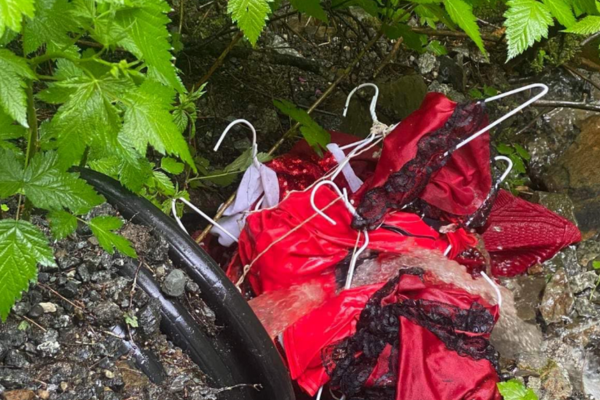
- Details
- By Elyse Wild
The garments were installed on May 15 to commemorate MMIP Awareness Month under a permit KIC held from the U.S. Forestry Service. By the time the installation was scheduled to come down on May 31, 48 of the dresses were missing. In recent days, photos have been surfacing on social media showing some of the dresses crumpled near the lakeside trail, half buried or discarded in piles near drain pipes.
The tribe’s council issued a statement condemning “a hurtful and disrespectful act that undermines the efforts to bring understanding and raise awareness about the MMIP epidemic.”
Similar installations are featured throughout Canada and the United States during May to bring awareness to the disproportionate number of Indigenous people who are victims of violent crimes or go missing.
Murder is the third leading cause of death for Native women, with the murder rate ten times higher than the national average for women living on reservations, according to the Centers for Disease Control and Prevention. In 2021, Alaska reported 229 cases of missing and murdered Indigenous persons — 149 missing and 80 murdered.
Gloria Burns, KIC’s vice president and the chair of the social services committee, told local radio station KRBD that the tribe hung the dresses with remembrance and intention in an effort to create a “safe space.”
“And so when you’re going through that process of trying to create a safe space, and then it’s intentionally made unsafe, it feels very much like a violation,” Burns told KRBD. “I think, you know, the hard part is that missing and murdered indigenous people, it’s been happening since colonization, we really don’t talk about it. We really haven’t spoken those to the outside community.”
Anyone with information on the vandalization is encouraged to contact local law enforcement.
More Stories Like This
Native News Weekly (August 25, 2024): D.C. BriefsUS Presidents in Their Own Words Concerning American Indians
Two Murdered on Colville Indian Reservation
NDAA passes House; Lumbee Fairness Act Advances
NFL, Vikings to Host Native All-American Game, Youth Flag Clinic
Help us defend tribal sovereignty.
At Native News Online, our mission is rooted in telling the stories that strengthen sovereignty and uplift Indigenous voices — not just at year’s end, but every single day.
Because of your generosity last year, we were able to keep our reporters on the ground in tribal communities, at national gatherings and in the halls of Congress — covering the issues that matter most to Indian Country: sovereignty, culture, education, health and economic opportunity.
That support sustained us through a tough year in 2025. Now, as we look to the year ahead, we need your help right now to ensure warrior journalism remains strong — reporting that defends tribal sovereignty, amplifies Native truth, and holds power accountable.
 The stakes couldn't be higher. Your support keeps Native voices heard, Native stories told and Native sovereignty defended.
The stakes couldn't be higher. Your support keeps Native voices heard, Native stories told and Native sovereignty defended.
Stand with Warrior Journalism today.
Levi Rickert (Potawatomi), Editor & Publisher


